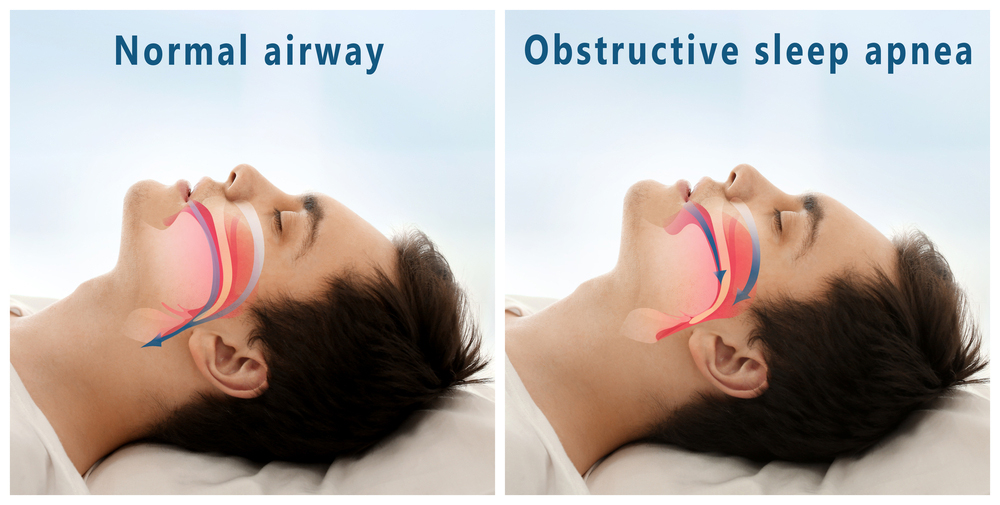
Obstructive sleep apnea (OSA) is a condition in which breathing stops involuntarily for brief periods of time during sleep. Normally, air flows smoothly from the mouth and nose into the lungs at all times. Periods when breathing stops are called apnea or apneic episodes. In OSA, the normal flow of air is repeatedly stopped throughout the night. The flow of air stops because airway space in the area of the throat is too narrow. Snoring is characteristic of obstructive sleep apnea. Snoring is caused by airflow squeezing through the narrowed airway space. Untreated sleep apnea can cause serious health problems such as:
- hypertension
- heart disease
- stroke
- diabetes
Proper diagnosis and treatment are essential to preventing complications.
Symptoms of Sleep Apnea
Sleep apnea causes episodes of decreased oxygen supply to the brain and other parts of the body. Sleep quality is poor, which causes daytime drowsiness and lack of clarity in the morning. People with sleep apnea may also experience the following symptoms:
- headaches that are difficult to treat
- feeling disgruntled (grumpy)
- forgetfulness
- drowsiness
Other symptoms include:
- hyperactivity in children
- worsening depression
- poor job and school performance
- loss of interest in sex
- leg swelling (called edema, which can occur when sleep apnea is severe)
Daytime drowsiness puts people with sleep apnea at risk for motor vehicle crashes and industrial accidents. Treatment can help to completely relieve daytime drowsiness caused by sleep apnea.
What Causes Obstructive Sleep Apnea?
There are several types of sleep apnea, but OSA is the most common. OSA is more likely to occur in older people and people who are overweight. Evidence shows that weight loss causes marked improvement in symptoms. Sleeping on your back can aggravate sleep apnea.
Treatment
The goal for treatment of sleep apnea is to make sure airflow isn’t obstructed during sleep. Treatment methods include:
Weight Loss
Weight loss gives excellent relief from the symptoms of OSA.
Nasal Decongestants
Nasal decongestants are more likely to be effective in mild OSA. They can help relieve snoring.
Continuous Positive Airway Pressure (CPAP)
Continuous positive airway pressure (CPAP) therapy is the first line of treatment for obstructive sleep apnea. CPAP is administered through a facemask that’s worn at night. The facemask gently delivers positive airflow to keep the airways open at night. The positive airflow props the airways open. CPAP is a highly effective treatment for sleep apnea. A dental device may also be necessary to keep the lower jaw positioned forward.
Bilevel Positive Airway Pressure (BiPAP or BPAP)
Bilevel positive airway pressure machines are sometimes used for the treatment of OSA if CPAP therapy is not effective. BiPAP machines have settings, high and low, that respond to your breathing. This means the pressure changes during inhaling versus exhaling.
Positional Therapy
Since sleeping on the back (supine position) can make sleep apnea worse for some people, positional therapy is used to help those with sleep apnea learn to sleep in other positions. Positional therapy and the use of CPAP can be discussed with a professional at a sleep center.
Surgery
Uvulopalatopharyngoplasty (UPPP) involves removal of extra tissues from the back of the throat. UPPP is the most common type of surgery for OSA, and it helps relieve snoring. However, this surgery hasn’t been proven to totally eliminate sleep apnea, and it can have complications.
Tracheostomymay be done as a procedure of last resort. Tracheostomy punctures an opening in the windpipe that bypasses the obstruction in the throat.
Other surgical procedures may be required to correct structural problems in the face and elsewhere when sleep apnea doesn’t respond to treatments such as CPAP. About 75 percent of children with OSA due to enlarged tonsils or adenoids get relief from surgery. The American Sleep Apnea Association (ASAA) says that the American Academy of Pediatrics has endorsed surgical removal of tonsils and adenoids as the treatment of choice for children with sleep problems due to enlarged tonsils or adenoids.